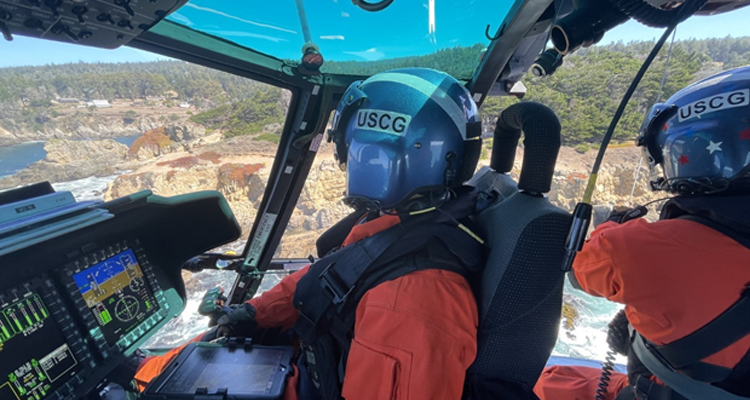Sept. 30, 2022 —

An MH-65E crew from Air Station San Francisco performs the unit’s first cliff rescue in an upgraded Echo aircraft when responding to a distress call from a capsized kayaker on the northern cliffs of Bodega Bay, California. U.S. Coast Guard photo.
The Coast Guard H-65 Conversion and Sustainment Program reached a major milestone Aug. 26 with the delivery of CGNR 6559 to Air Station San Francisco, marking the halfway point in its effort to upgrade the service’s short range recovery helicopter fleet to the Echo configuration. Coast Guard aircrews who have transitioned to the upgraded aircraft agree that the increased capabilities are vital in carrying out their full range of missions more safely and effectively.
The value of the new capabilities was illuminated when an Air Station San Francisco aircrew recently performed their first cliff rescue/vertical surface evolution in the MH-65E after receiving a man overboard distress call from a capsized kayaker.
After finding the man on the cliffs near Bodega Bay, California, and taking him to safety, the San Francisco duty pilots noted the new Common Avionics Architecture System (CAAS) features helped them with their decision-making as the search and rescue case progressed. They were equally impressed by the bingo fuel alerts, an aviator term used to describe the minimum fuel an aircraft requires to land safely at its designated landing site. Additionally, the upgrades allowed the left seat pilot to monitor the progress of the rescue by pulling up the video source from the hoist camera with the new inboard multi-function display (MFD).
“The fleet is continually noting their confidence in CAAS and the accuracy of flight planning and fuel calculations,” said Cmdr. Karyn Forsyth, MH-65 program manager. “I applaud the left seater in this mission for adding to his situational awareness by having the hoist camera video displayed on the inboard MFD. We didn’t have this capability in the legacy H-65D.”
Another benefit of the upgrades was evident to a pilot newly trained on the MH-65E platform during the flight from the Aviation Logistics Center in Elizabeth City, North Carolina – where the upgrades are implemented – to San Francisco. “The color weather radar was key in avoiding numerous storms and convective activity, while the detailed terrain mapping proved especially useful in navigating the Rocky and Sierra Nevada Mountains,” said Lt. Cassandra Hawley of Air Station San Francisco. The air station received its first MH-65E in June 2022 and will receive its seventh and final upgraded aircraft in early October.
Though plans are in place to eventually transition to an all MH-60T fleet, the smaller MH-65’s role in saving lives is far from finished. “This aircraft isn’t going away any time soon,” Forsyth noted. “The Coast Guard has invested time and resources in modernizing and extending the service life of the H-65 fleet and we will continue to be committed to this aircraft and train our aircrews to maintain Coast Guard operational capability until we transition the service to a single-airframe fleet of only MH-60s.”
Until then, the MH-65Es and their operators will continue to save lives in these newly outfitted and highly capable airframes. The Echoes have already contributed to 175 lives saved and 113 assisted saves since their initial operation began.
In conjunction with the upgrades, the Coast Guard is completing service life extension program activities on the Dolphin fleet to replace five major structural components: the nine-degree frame, canopy, center console floor assembly, floorboards and side panels. These mission-critical improvements are designed to extend the service life of the helicopter by 10,000 flight hours.
The Coast Guard plans to convert all 98 aircraft to the MH-65E configuration by the end of fiscal year 2024.
For more information: MH-65 Program page